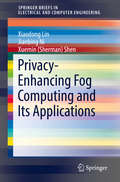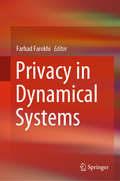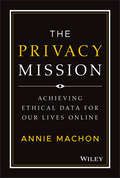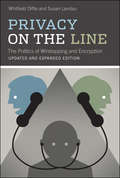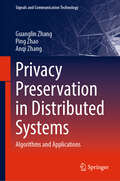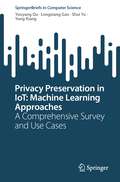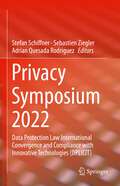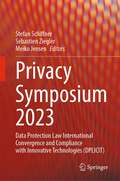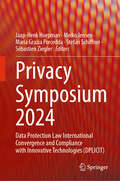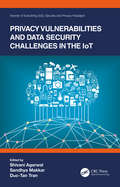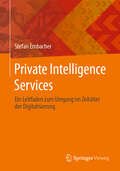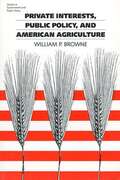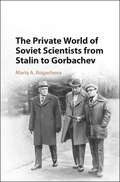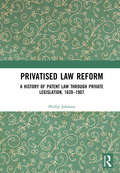- Table View
- List View
Privacy-Enhancing Aggregation Techniques for Smart Grid Communications
by Rongxing LuThis book provides an overview of security and privacy issues in smart grid communications, as well as the challenges in addressing these issues. It also introduces several privacy enhancing aggregation techniques including multidimensional data aggregation, subset data aggregation, multifunctional data aggregation, data aggregation with fault tolerance, data aggregation with differential privacy, and data aggregation with integrity protection. Offering a comprehensive exploration of various privacy preserving data aggregation techniques, this book is an exceptional resource for the academics, researchers, and graduate students seeking to exploit secure data aggregation techniques in smart grid communications and Internet of Things (IoT) scenarios.
Privacy-Enhancing Fog Computing and Its Applications (SpringerBriefs in Electrical and Computer Engineering)
by Xiaodong Lin Jianbing Ni Xuemin Sherman ShenThis SpringerBrief covers the security and privacy challenges in fog computing, and proposes a new secure and privacy-preserving mechanisms to resolve these challenges for securing fog-assisted IoT applications. Chapter 1 introduces the architecture of fog-assisted IoT applications and the security and privacy challenges in fog computing. Chapter 2 reviews several promising privacy-enhancing techniques and illustrates examples on how to leverage these techniques to enhance the privacy of users in fog computing. Specifically, the authors divide the existing privacy-enhancing techniques into three categories: identity-hidden techniques, location privacy protection and data privacy enhancing techniques. The research is of great importance since security and privacy problems faced by fog computing impede the healthy development of its enabled IoT applications. With the advanced privacy-enhancing techniques, the authors propose three secure and privacy-preserving protocols for fog computing applications, including smart parking navigation, mobile crowdsensing and smart grid. Chapter 3 introduces identity privacy leakage in smart parking navigation systems, and proposes a privacy-preserving smart parking navigation system to prevent identity privacy exposure and support efficient parking guidance retrieval through road-side units (fogs) with high retrieving probability and security guarantees. Chapter 4 presents the location privacy leakage, during task allocation in mobile crowdsensing, and propose a strong privacy-preserving task allocation scheme that enables location-based task allocation and reputation-based report selection without exposing knowledge about the location and reputation for participators in mobile crowdsensing. Chapter 5 introduces the data privacy leakage in smart grid, and proposes an efficient and privacy-preserving smart metering protocol to allow collectors (fogs) to achieve real-time measurement collection with privacy-enhanced data aggregation. Finally, conclusions and future research directions are given in Chapter 6. This brief validates the significant feature extension and efficiency improvement of IoT devices without sacrificing the security and privacy of users against dishonest fog nodes. It also provides valuable insights on the security and privacy protection for fog-enabled IoT applications. Researchers and professionals who carry out research on security and privacy in wireless communication will want to purchase this SpringerBrief. Also, advanced level students, whose main research area is mobile network security will also be interested in this SpringerBrief.
Privacy in Context
by Helen NissenbaumPrivacy is one of the most urgent issues associated with information technology and digital media. This book claims that what people really care about when they complain and protest that privacy has been violated is not the act of sharing information itself-most people understand that this is crucial to social life -but the inappropriate, improper sharing of information. Arguing that privacy concerns should not be limited solely to concern about control over personal information, Helen Nissenbaum counters that information ought to be distributed and protected according to norms governing distinct social contexts-whether it be workplace, health care, schools, or among family and friends. She warns that basic distinctions between public and private, informing many current privacy policies, in fact obscure more than they clarify. In truth, contemporary information systems should alarm us only when they function without regard for social norms and values, and thereby weaken the fabric of social life.
Privacy in Dynamical Systems
by Farhad FarokhiThis book addresses privacy in dynamical systems, with applications to smart metering, traffic estimation, and building management. In the first part, the book explores statistical methods for privacy preservation from the areas of differential privacy and information-theoretic privacy (e.g., using privacy metrics motivated by mutual information, relative entropy, and Fisher information) with provable guarantees. In the second part, it investigates the use of homomorphic encryption for the implementation of control laws over encrypted numbers to support the development of fully secure remote estimation and control. Chiefly intended for graduate students and researchers, the book provides an essential overview of the latest developments in privacy-aware design for dynamical systems.
The Privacy Mission: Achieving Ethical Data for Our Lives Online
by Annie MachonFuture-proof yourself and your organization against known threats to privacy and online safety The subject of data ethics has never been more urgent. This is no longer an academic or niche geek issue as it has been since the inception of the internet and the world wide web. Data ethics is an issue that affects all of us now as our personal and professional lives increasingly take place online. Who controls access to the hardware, who runs the software, who can spy on us, hack us, data farm us? What are the threats that we need to mitigate against democratically, societally, and personally? How can corporations protect us and how can that help their bottom line?The Privacy Mission aims to answer these questions and summarise both the overarching concepts and principles about why data ethics is important. It offers practical solutions for companies, policy makers and individuals to push back against known threats and future proof themselves going forward.
Privacy on the Line, updated and expanded edition: The Politics of Wiretapping and Encryption
by Whitfield Diffie Susan LandauA penetrating and insightful study of privacy and security in telecommunications for a post-9/11, post-Patriot Act world.Telecommunication has never been perfectly secure. The Cold War culture of recording devices in telephone receivers and bugged embassy offices has been succeeded by a post-9/11 world of NSA wiretaps and demands for data retention. Although the 1990s battle for individual and commercial freedom to use cryptography was won, growth in the use of cryptography has been slow. Meanwhile, regulations requiring that the computer and communication industries build spying into their systems for government convenience have increased rapidly. The application of the 1994 Communications Assistance for Law Enforcement Act has expanded beyond the intent of Congress to apply to voice over Internet Protocol (VoIP) and other modern data services; attempts are being made to require ISPs to retain their data for years in case the government wants it; and data mining techniques developed for commercial marketing applications are being applied to widespread surveillance of the population.In Privacy on the Line, Whitfield Diffie and Susan Landau strip away the hype surrounding the policy debate over privacy to examine the national security, law enforcement, commercial, and civil liberties issues. They discuss the social function of privacy, how it underlies a democratic society, and what happens when it is lost. This updated and expanded edition revises their original—and prescient—discussions of both policy and technology in light of recent controversies over NSA spying and other government threats to communications privacy.
Privacy Preservation in Distributed Systems: Algorithms and Applications (Signals and Communication Technology)
by Anqi Zhang Ping Zhao Guanglin ZhangThis book provides a discussion of privacy in the following three parts: Privacy Issues in Data Aggregation; Privacy Issues in Indoor Localization; and Privacy-Preserving Offloading in MEC. In Part 1, the book proposes LocMIA, which shifts from membership inference attacks against aggregated location data to a binary classification problem, synthesizing privacy preserving traces by enhancing the plausibility of synthetic traces with social networks. In Part 2, the book highlights Indoor Localization to propose a lightweight scheme that can protect both location privacy and data privacy of LS. In Part 3, it investigates the tradeoff between computation rate and privacy protection for task offloading a multi-user MEC system, and verifies that the proposed load balancing strategy improves the computing service capability of the MEC system. In summary, all the algorithms discussed in this book are of great significance in demonstrating the importance of privacy.
Privacy Preservation in IoT: A Comprehensive Survey and Use Cases (SpringerBriefs in Computer Science)
by Youyang Qu Longxiang Gao Shui Yu Yong XiangThis book aims to sort out the clear logic of the development of machine learning-driven privacy preservation in IoTs, including the advantages and disadvantages, as well as the future directions in this under-explored domain. In big data era, an increasingly massive volume of data is generated and transmitted in Internet of Things (IoTs), which poses great threats to privacy protection. Motivated by this, an emerging research topic, machine learning-driven privacy preservation, is fast booming to address various and diverse demands of IoTs. However, there is no existing literature discussion on this topic in a systematically manner. The issues of existing privacy protection methods (differential privacy, clustering, anonymity, etc.) for IoTs, such as low data utility, high communication overload, and unbalanced trade-off, are identified to the necessity of machine learning-driven privacy preservation. Besides, the leading and emerging attacks pose further threats to privacy protection in this scenario. To mitigate the negative impact, machine learning-driven privacy preservation methods for IoTs are discussed in detail on both the advantages and flaws, which is followed by potentially promising research directions. Readers may trace timely contributions on machine learning-driven privacy preservation in IoTs. The advances cover different applications, such as cyber-physical systems, fog computing, and location-based services. This book will be of interest to forthcoming scientists, policymakers, researchers, and postgraduates.
Privacy-Preserving Techniques with e-Healthcare Applications (Wireless Networks)
by Dan Zhu Dengguo Feng Xuemin (Sherman) ShenThis book investigates novel accurate and efficient privacy-preserving techniques and their applications in e-Healthcare services. The authors first provide an overview and a general architecture of e-Healthcare and delve into discussions on various applications within the e-Healthcare domain. Simultaneously, they analyze the privacy challenges in e-Healthcare services. Then, in Chapter 2, the authors give a comprehensive review of privacy-preserving and machine learning techniques applied in their proposed solutions. Specifically, Chapter 3 presents an efficient and privacy-preserving similar patient query scheme over high-dimensional and non-aligned genomic data; Chapter 4 and Chapter 5 respectively propose an accurate and privacy-preserving similar image retrieval scheme and medical pre-diagnosis scheme over dimension-related medical images and single-label medical records; Chapter 6 presents an efficient and privacy-preserving multi-disease simultaneous diagnosis scheme over medical records with multiple labels. Finally, the authors conclude the monograph and discuss future research directions of privacy-preserving e-Healthcare services in Chapter 7.
Privacy, Security And Forensics in The Internet of Things (IoT)
by Ian Mitchell Reza Montasari Fiona Carroll Sukhvinder Hara Rachel Bolton-KingThis book provides the most recent security, privacy, technical and legal challenges in the IoT environments. This book offers a wide range of theoretical and technical solutions to address these challenges. Topics covered in this book include; IoT, privacy, ethics and security, the use of machine learning algorithms in classifying malicious websites, investigation of cases involving cryptocurrency, the challenges police and law enforcement face in policing cyberspace, the use of the IoT in modern terrorism and violent extremism, the challenges of the IoT in view of industrial control systems, and the impact of social media platforms on radicalisation to terrorism and violent extremism.This book also focuses on the ethical design of the IoT and the large volumes of data being collected and processed in an attempt to understand individuals’ perceptions of data and trust. A particular emphasis is placed on data ownership and perceived rights online. It examines cyber security challenges associated with the IoT, by making use of Industrial Control Systems, using an example with practical real-time considerations. Furthermore, this book compares and analyses different machine learning techniques, i.e., Gaussian Process Classification, Decision Tree Classification, and Support Vector Classification, based on their ability to learn and detect the attributes of malicious web applications. The data is subjected to multiple steps of pre-processing including; data formatting, missing value replacement, scaling and principal component analysis. This book has a multidisciplinary approach. Researchers working within security, privacy, technical and legal challenges in the IoT environments and advanced-level students majoring in computer science will find this book useful as a reference. Professionals working within this related field will also want to purchase this book.
Privacy Symposium 2022: Data Protection Law International Convergence and Compliance with Innovative Technologies (DPLICIT)
by Stefan Schiffner Sebastien Ziegler Adrian Quesada RodriguezThis book presents a collection of high-quality research works and professional perspectives arising from the call for papers of the Privacy Symposium 2022; an international conference aimed towards the promotion of international dialogue, cooperation and knowledge sharing on data protection regulations, compliance and emerging technologies. Gathering legal and technology expertise, this publication provides cutting-edge perspectives on the convergence of international data protection regulations, as well as data protection compliance of emerging technologies, such as: Artificial Intelligence, e-health, blockchain, edge computing, Internet of things, V2X and Smart Grids. It includes selected papers from the Privacy Symposium conference 2022 (PSC 2022) call for papers, encompassing relevant topics, including: international law and comparative law in data protection cross-border data transfers emerging technologies and data protection compliance data protection by design technologic solutions for data protection compliance data protection good practices across industries and verticals cybersecurity and data protection assessment and certification of data protection compliance, and data subject rights implementation This publication includes papers authored by academics and professionals involved on various areas of data protection, technical, legal and compliance services.Chapter 10 is available open access under a Creative Commons Attribution 4.0 International License via link.springer.com
Privacy Symposium 2023: Data Protection Law International Convergence and Compliance with Innovative Technologies (DPLICIT)
by Stefan Schiffner Sébastien Ziegler Meiko JensenThis book presents the proceedings of the Privacy Symposium 2023. the book features a collection of high-quality research works and professional perspectives on personal data protection and emerging technologies. Gathering legal and technology expertise, it provides cutting-edge perspective on international data protection regulations convergence, as well as data protection compliance of emerging technologies, such as artificial intelligence, e-health, blockchain, edge computing, Internet of Things, V2X and smart grid. Papers encompass various topics, including international law and comparative law in data protection and compliance, cross-border data transfer, emerging technologies and data protection compliance, data protection by design, technology for compliance and data protection, data protection good practices across industries and verticals, cybersecurity and data protection, assessment and certification of data protection compliance, and data subject rights implementation.
Privacy Symposium 2024: Data Protection Law International Convergence and Compliance with Innovative Technologies (DPLICIT)
by Jaap-Henk Hoepman Meiko Jensen Maria Grazia Porcedda Stefan Schiffner Sébastien ZieglerThis book presents the proceedings of the Privacy Symposium 2024. The book features a collection of high-quality research works and professional perspectives on personal data protection and emerging technologies. Gathering legal and technology expertise, it provides cutting-edge perspective on international data protection regulations convergence, as well as data protection compliance of emerging technologies, such as artificial intelligence, e-health, blockchain, edge computing, Internet of Things, V2X, and smart grid. Papers encompass various topics, including international law and comparative law in data protection and compliance, cross-border data transfer, emerging technologies and data protection compliance, data protection by design, technology for compliance and data protection, data protection good practices across industries and verticals, cybersecurity and data protection, assessment and certification of data protection compliance, and data subject rights implementation.
Privacy Vulnerabilities and Data Security Challenges in the IoT (Internet of Everything (IoE))
by Shivani Agarwal, Sandhya Makkar, and Duc-Tan TranThis book discusses the evolution of security and privacy issues in the Internet of Things (IoT). The book focuses on assembling all security- and privacy-related technologies into a single source so that students, researchers, academics, and those in the industry can easily understand the IoT security and privacy issues. This edited book discusses the use of security engineering and privacy-by-design principles to design a secure IoT ecosystem and to implement cyber-security solutions. This book takes the readers on a journey that begins with understanding security issues in IoT-enabled technologies and how these can be applied in various sectors. It walks readers through engaging with security challenges and building a safe infrastructure for IoT devices. The book helps researchers and practitioners understand the security architecture of IoT and the state-of-the-art in IoT countermeasures. It also differentiates security threats in IoT-enabled infrastructure from traditional ad hoc or infrastructural networks, and provides a comprehensive discussion on the security challenges and solutions in RFID and WSNs in IoT. This book aims to highlight the concepts of related technologies and novel findings by researchers through its chapter organization. The primary audience comprises specialists, researchers, graduate students, designers, experts, and engineers undertaking research on security-related issues.
Private Intelligence Services: Ein Leitfaden zum Umgang im Zeitalter der Digitalisierung
by Stefan EmbacherDie Einführung des Buches legt den Grundstein für die nachfolgenden Kapitel, indem sie die Definitionen und Grundlagen der Wirtschaftskriminalität klärt und ein solides Verständnis für die Dimensionen und die Tragweite dieser Herausforderung schafft. Sie legt dar, wie Wirtschaftskriminalität nicht nur finanzielle Verluste verursacht, sondern auch das Vertrauen in Märkte und Institutionen untergräbt, was weitreichende soziale und wirtschaftliche Konsequenzen nach sich zieht. Im ersten Kapitel wird die Zusammenarbeit zwischen privaten Intelligence-Unternehmen und staatlichen Behörden beleuchtet. Es werden Fallstudien und Beispiele präsentiert, die demonstrieren, wie eine erfolgreiche Partnerschaft aussehen kann, und welche Herausforderungen und Spannungsfelder dabei auftreten können. Das Kapitel unterstreicht die Bedeutung von Vertrauen, Transparenz und gegenseitigem Respekt für den Erfolg dieser Kooperationen. Das zweite Kapitel widmet sich den spezifischen Herausforderungen und Anforderungen, die verschiedene Branchen und Sektoren an private Intelligence-Unternehmen stellen. Es wird detailliert aufgezeigt, wie unterschiedlich die Bedürfnisse von Unternehmen, je nach Größe, Branche und geografischer Lage sein können, und wie maßgeschneiderte Lösungen aussehen können. Es wird deutlich, dass eine tiefgehende Branchenkenntnis und Spezialisierung essentiell sind, um effektive Dienstleistungen zu bieten. Das dritte Kapitel ist in mehrere Unterkapitel gegliedert und deckt ein breites Spektrum an Themen ab, darunter die besonderen Anforderungen bestimmter Zielgruppen, Methoden und Techniken zur Sicherung von Vermögenswerten und Informationen, sowie praxisnahe Fallbeispiele und Best Practices. Hier wird auch aufgezeigt, wie Unternehmen wie Foreus als Dienstleister in der Praxis agieren und welche Rolle sie im Gesamtkontext spielen. Das vierte Kapitel setzt sich mit den rechtlichen und ethischen Aspekten von Private Intelligence auseinander. Es werden aktuelle Gesetzgebungen und Rechtsprechungen diskutiert, ethische Dilemmata beleuchtet und klare Empfehlungen und Richtlinien für verantwortungsvolles Handeln präsentiert. Das fünfte Kapitel blickt in die Zukunft und versucht eine Prognose über die nächsten 10 Jahre im Bereich Private Intelligence und Wirtschaftskriminalität abzugeben. Es werden technologische Entwicklungen, Ausbildungs- und Weiterbildungsmöglichkeiten sowie potentielle Herausforderungen und Chancen diskutiert. Das abschließende sechste Kapitel fasst die zentralen Erkenntnisse zusammen, bietet konkrete Handlungsempfehlungen für verschiedene Fachleute und endet mit abschließenden Gedanken und einem Ausblick in die Zukunft.
Private Interests, Public Policy, and American Agriculture
by William P. BrowneFor nearly a decade William P. Browne has studied the major farm organizations, congressional hearings and records related to agricultural issues, and the American Agricultural Movement. But perhaps his richest source of information has been extensive interviews with lobbyists, executives, and grassroots activists during and just after the 1985 farm bill debates. In the course of his research, Browne sought to learn how interest groups behave in deciding their policy priorities and how this behavior actually relates to influence over the desired policy outcomes.
PRIVATE LIVES
by Karen YoungElizabeth Walker has spent most of the past three decades trying to forget the loss of her mother and father, a lonely childhood spent in a series of foster homes and the two baby sisters she hasn't seen in twenty-five years. She values her privacy above everything, and has built a wall around herself that few people have ever climbed.But when her best friend, Gina, risks losing her young daughter to an impersonal court system-the same system that failed Elizabeth many years ago-she vows to fight back. But Elizabeth needs help. She needs the kind of help that a family can give, and she needs Ryan Paxton, the brilliant attorney whose tragic family history is intertwined with her own.As the custody battle turns to something more dangerous-and more deadly-Elizabeth comes face-to-face with a past she has tried to forget and a future she wants to embrace.
Private or Socialistic Forestry?: Forest Transition in Finland vs. Deforestation in the Tropics
by Matti Palo Erkki LehtoWhile deforestation continues at an alarming rate around the world, discussions on the range of underlying causes continue. The premise is that studying successful transitions from deforestation to sustainable forestry ex post in Finland can provide novel insights into how deforestation in the tropics might be reduced in the future. Our fundamental question here is why Finland succeeded to stop deforestation for a century ago and why not the same is feasible in the contemporary tropical countries? This book presents a novel integrated theory within which this case study on Finland and contemporary modeling of underlying causes of tropical deforestation are developed. Finland remains the world's second largest net exporter of forest products, while maintaining the highest forest cover in Europe. A transition from deforestation to sustainable industrial forestry took place in Finland during the first part of the 20th century. The underlying causes of this transition are compared via our theory with deforestation in 74 contemporary tropical countries. Both appear similar and support our theory. The interaction of public policies and market institutions has appeared to be critical during this transition. The study's findings suggest that private forest ownership with a continuous increase in the real value of forests and alleviation of poverty under non-corruptive conditions has been a necessary, but not a sufficient, condition for this transition. In a parallel way public policies have also proved to be a necessary, but not sufficient, condition in this transition. The conclusion is that socialistic forestry along with corruption is artificially maintaining too low values in the tropical forests. The opportunity cost of sustainable forestry remains too high and deforestation by extensification of agriculture therefore continues. The prevailing socialistic forestry with dominating public forest ownership is by purpose maintaining administratively set low stumpage prices leading to low value of forests, wide corruption and continuous forest degradation and deforestation. An effective remedy - to raise the value of forests - is found to be within forestry.
Private Pilot Practical Test Standards for Airplane (Practical Test Standards series)
by Federal Aviation AdministrationTopics include weather pattern recognition, physiological conditions, flight planning exercises, takeoff and landing techniques, checklist usage, flight controls, and crew resource management. The book provides background information and reference materials for license candidates to review, such as the proper altitude, airspeed, headings, and banks used for each particular maneuver.
Private Rights in Public Resources: Equity and Property Allocation in Market-Based Environmental Policy
by Professor Leigh RaymondPrivatizing public resources by creating stronger property rights, including so-called rights to pollute, is an increasingly popular environmental policy option. While advocates of this type of market-based environmental policy tend to focus on its efficiency and ecological implications, such policies also raise important considerations of equity and distributive justice. Private Rights in Public Resources confronts these ethical implications directly, balancing political theory and philosophy with detailed analysis of the politics surrounding three important policy instruments--the Kyoto Protocol, the 1990 Clean Air Act Amendments, and the 1934 Taylor Grazing Act. Author Leigh Raymond reviews legislative records and administrative documents and interviews key policymakers. Confirming that much of the debate in the selected policies centers on the equity or fairness of the initial allocation of property rights, he applies the theories of John Locke, Morris Cohen, and others to build a framework for identifying the competing norms of equity in play. Raymond's study reveals that, despite the different historical and ecological settings, the political actors struggled to reconcile similar arguments-and were often able to achieve a similar synthesis of conflicting ownership ideas. Rather than offering a familiar argument for or against these policies on ethical grounds, the book explains how ideas about equity help determine a policy's political fate. Shedding light on the complex equity principles used to shape and evaluate these controversial initiatives, this empirical analysis will be of interest to those on all sides of the debate over market-based policies, as well as those interested in the role of normative principles in politics more generally.
Private Screenings: Television and the Female Consumer
by Lynn Spigel Denise MannPrivate Screenings brings together essays that focus on the relationship among women, television, and consumer culture.
Private Sector Housing and Health: Evaluating the Effectiveness of Regulation Intended to Protect the Health of Tenants (Routledge Focus on Environmental Health)
by Paul OattThis book is an evaluation of the effectiveness of housing enforcement and tenant protection in England’s private rented sector using policy analysis to evaluate regulatory provisions and local authority guidance to identify the advantages and limitations of existing policies. From the environmental health practitioner perspective, the targeted health problem is occupiers privately renting from negligent or criminal landlords who are subsequently exposed to hazardous conditions arising from disrepair.Paul Oatt’s analysis looks at the powers local authorities have to address retaliatory eviction when enforcing against housing disrepair and digs deeper into their duties to prevent homelessness and powers to protect tenants from illegal eviction. He then explores the potential for tenants to take private action against landlords over failures to address disrepair, before finally discussing proposals put forward by the government to abolish retaliatory evictions and improve security of tenure with changes to contractual arrangements between landlords and tenants, based on successive stakeholder consultations. The policy analysis looks at these aspects to define the overall effectiveness of housing strategies and their implementation, examining causality, plausibility and intervention logic as well as the unintended effects on the population. Equitability is examined to see where policy effects create inequalities as well as the costs, feasibility and acceptability of policies from landlords' and tenants’ perspectives. The book will be of relevance to professionals interested in housing and health, as well as students at universities that teach courses in environmental health, public health, and housing studies.
Private Vegas (Private)
by James Patterson Maxine PaetroLas Vegas is a city of contradictions: seedy and glamorous, secretive and wild, Vegas attracts people of all kinds--especially those with a secret to hide, or a life to leave behind. It's the perfect location for Lester Olsen's lucrative business. He gets to treat gorgeous, young women to five-star restaurants, splashy shows, and limo rides--and then he teaches them how to kill. Private Jack Morgan spends most of his time in Los Angeles, where his top investigation firm has its headquarters. But a hunt for two criminals leads him to the city of sin--and to a murder ring that is more seductively threatening than anything he's witnessed before. PRIVATE VEGAS brings James Patterson's Private series to a sensational new level.
The Private World of Soviet Scientists from Stalin to Gorbachev
by Rogacheva Maria A.Rogacheva sheds new light on the complex transition of Soviet society from Stalinism into the post-Stalin era. Using the case study of Chernogolovka, one of dozens of scientific towns built in the USSR under Khrushchev, she explains what motivated scientists to participate in the Soviet project during the Cold War. Rogacheva traces the history of this scientific community from its creation in 1956 through the Brezhnev period to paint a nuanced portrait of the living conditions, political outlook, and mentality of the local scientific intelligentsia. Utilizing new archival materials and an extensive oral history project, this book argues that Soviet scientists were not merely bought off by the Soviet state, but that they bought into the idealism and social optimism of the post-Stalin regime. Many shared the regime's belief in the progressive development of Soviet society on a scientific basis, and embraced their increased autonomy, material privileges and elite status.
Privatised Law Reform: A History Of Patent Law Through Private Legislation, 1620-1907
by Phillip JohnsonIn the history of British patent law, the role of Parliament is often side-lined. This is largely due to the raft of failed or timid attempts at patent law reform. Yet there was another way of seeking change. By the end of the nineteenth century, private legislation had become a mechanism or testing ground for more general law reforms. The evolution of the law had essentially been privatised and was handled in the committee rooms in Westminster. This is known in relation to many great industrial movements such as the creating of railways, canals and roads, or political movements such as the powers and duties of local authorities, but it has thus far been largely ignored in the development of patent law. This book addresses this shortfall and examines how private legislation played an important role in the birth of modern patent law.

